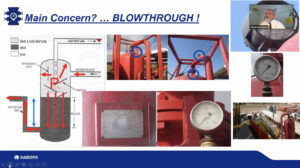Equipment placement, monitoring critical to ensure mud/gas separator safety

By Stephen Whitfield, Associate Editor
Mud/gas separators are in use on almost all drilling locations, and understanding how to identify and prevent common problems that affect their performance can be critical to ensuring safe operations. At the 2021 IADC Well Control Conference of the Americas on 24 August, Richard Grayson, Senior QHSE Manager and Global Well Control Focal Point at Nabors Industries, discussed some of the steps his organization takes to prevent one of the main issues – blow-through – that could create a catastrophic failure.
A mud/gas separator is a vertical steel cylindrical body with openings on the top (gas vent line), bottom (mud return line) and side (separator inlet). A mud and gas mixture feeds into the separator inlet and led to a flat steel plate positioned perpendicular to the flow. This plate minimizes the erosion wear on the separator’s internal walls and assists with mud/gas separation. This separation continues as the mud/gas mixture falls over a series of baffles designed to increase turbulence over the upper section of the vessel, with the free gas venting through the gas vent line and the mud being returned to the mud tanks.
Blow-through occurs when the friction pressure of the gas venting through the vent line exceeds the hydrostatic pressure in the mud. This can lead to the gas pushing down on the mud and, ultimately, breaking the mud seal at the bottom of the tank. This could send a mud/gas mixture through the mud return line and into the mud tank, increasing the risk of fire. Given that driling mud is often oil-based, a fire in the mud tank could potentially lead to what Mr Grayson termed a “total constructive loss” of the tank.
In the event of a blow-through, the first thing the rig crew should do is stop pumping and shut in the well, Mr Grayson said. After refilling the mud return line and checking for obstructions that may have prevented gas from flowing cleanly through the vent line, the crew can resume pumping at a slower speed – he recommended pumping at half speed – until it is clear that the separator is working properly.
Nabors has noted several options for identifying potential blow-through, recognizing that it is critical to ensuring continual safe performance of the separator. The first option is to simply place a gauge at the top of the separator tank, near the gas vent line. This allows personnel to monitor the friction pressure more closely. If the pressure goes above previously observed hydrostatic pressure in the mud, this is an indication that blow-through is imminent.
Nabors often has operators ask the company to install gauges at the top of the tank, and that it can be effective given the use of the right gauge. The hydrostatic pressure in a typical mud/gas separator is generally around 7 psi, so it is important for rig crews to use gauges where that number can be read easily. Mr Grayson noted instances where operators have requested the installation 0-200 psi gauges on separators, or gauges that go up to a level greater than the maximum allowable pressure in a tank.
“If I have a 0-200 psi gauge, can I read 7 psi on that gauge? I would say no,” Mr Grayson said. “We’re looking for pressures in the range of 4-5 psi, up to about 12-15. We’re not looking for any pressure higher than that to exist in this tank. If I find a gauge like this, I have a sit-down with the rig manager and I ask, what are we really doing? And then we get a different gauge.”
Nabors also identifies potential blow-through by installing pressure transducers, or sensors that measure fluid pressure, at the gas vent line, the top of the mud return line and the bottom of the mud return line. These transducers send pressure data to an interface within Nabors’ RigCloud platform. This provides real-time monitoring capabilities from any location, as opposed to relying on a crew member to occasionally check the pressure off of a gauge, Mr Grayson said.
“If you use the pressure transducers, a number of things become possible,” he said. “You can determine the hydrostatic pressure in the return line. You can determine if the pressure at the top of the tank is greater than the pressure at the bottom of the return leg. If we put instruments on a mud/gas separator, the driller’s got this information that he can look at from his control station, or wherever we have a readout. This is a way for us to keep an eye on what’s happening inside the separator.”
Another step that could be taken is to calibrate sensors to monitor the height of the fluid level within the separator tank. This gives drillers another indication of how close gas may be to reaching the mud return line, Mr Grayson said.
Beyond gauges and sensors, check valves, or non-return valves, can also be valuable. These valves are often installed into the vent line to ensure that there is constant flow in a single direction; in case of a fire, these valves would help prevent that fire from flowing back into the separator.
The placement of these check valves is important. Some drilling contractors like to place them near the flare stack, where fire is more likely to occur, but Nabors recommended placing them next to the separator tank, where they can act as a last line of defense.
“We don’t think that placement next to the flare is the best place because the flame can potentially get past that and then work its way into the mud/gas separator,” he explained. “Then you can have an explosion take place that literally ruptures the vessel. Placing them next to the mud/gas separator gives us the maximum opportunity to protect that separator.”




